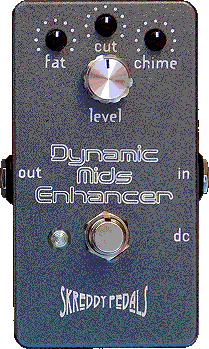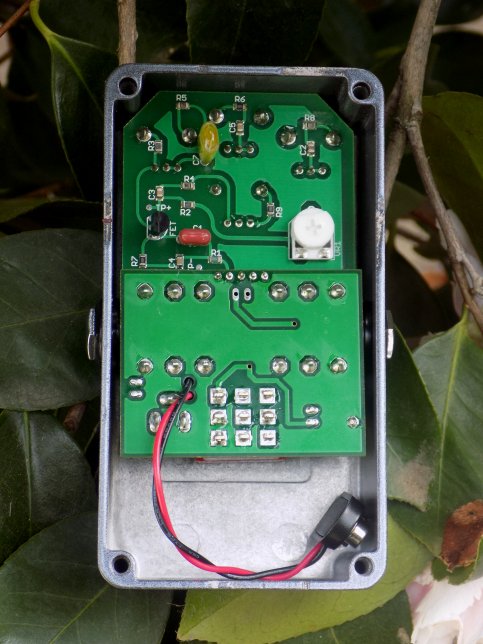Released 1 – ? – 16 Official Skreddy DME Page HERE


Marc says:
This is crystal clean, with no added noise or clipping or even a hint of harshness. Instead of traditional band-pass eq filters, it employs a minimalist signal path to avoid redundant gain stages (which add noise and alter tone) or distortion caused by phase shifting (which all traditional filters impart) or any sort of “processed” sound. Just more of what you want to hear (detail and dimensionality) and that’s all. This design represents my first foray into anything resembling a clean boost, as I’ve never before heard one that I liked or even thought was worthwhile. But it works equally well clean and stacked with dirt. I recommend using it AFTER your dirt pedals to hear all the benefit, as most of its subtlety would be lost when used in front of dirt, where it would just increase the dirt’s saturation and mids but ultimately yield the same eq footprint and output volume and limited dynamics that the dirt pedal creates on its own. I mean yeah, if you just want more saturation and sustain and mid focus, then fine; put it in front of a dirt pedal; but the clean volume gain will also increase the noise floor (e.g., your guitar hum) that the dirt pedal will then amplify; and I really love what it does after dirt pedals, where it increases peak volume but not noise.
just clean, expanded peak volume and enhanced detail, focus, and cut (depending on how you set the trimmers of course). It kind of de-compresses the sound and pulls the articulation out even from a heavy fuzz. This thing sounds good even with all 3 frequency trimmers down, but it’s lovely and fun to play with different combinations and levels of boosts.
I don’t want to divulge all the design details, but it yeah it has the function of an expander, since it leaves the noisy frequencies fairly flat while amplifying the parts of the signal where your guitar’s voice lives. At maximum boost, it will amplify the noise floor somewhat along with everything else, but the signal peaks will be many, many times louder; so it is expanding though there is no noise gate function whatsoever. It does take the compressed output of a mushy fuzz and “re-animate” it with restored dynamics and string-attack and clarity. The extra boost can add to the ability of controlled feedback when used in conjunction with high-gain dirt.
The output impedance is in the 8k range, like a typical humbucker. The loss of some highs is presumed and desirable, since we are only interested in boosting the useful frequencies and losing the “hiss” frequencies; but the brightness you want is all being boosted. No loss of any actually desirable highs takes place.
It’s not all that technically complex; it has the side effect of sounding like an expander when in actual use. Extra clean gain, noise free, focused on the useful guitar frequencies and nothing extra. Just happens to make the dynamics and details pop.
The capacitor materials I chose will ensure that only the “chime” control will bring up the high end; plus I padded each control so that the “fat” and “cut” will stay slightly lower than the “chime” at max and emphasize clarity at all settings. This prevents the lows from getting too swampy or the mids from getting too congested and lets them all overlap but still remain somewhat distinct even when all 3 are cranked. Even the “chime” control is very slightly padded so that at max it will emphasize bright string attack but not to the level of harshness.
The DME gives a fuzz the teeth and punch it needs to cut through a live mix. it takes a fuzz that sounds mushy and overly compressed and restores its dynamics and clarity.
It is very similar to a solid-state Echoplex preamp pedal except that it has no muddiness (nor extra high-end “sheen” as noted above) and it has variable gain controls in 3 different voicings. It’s not an EQ, though its knob labels may appear like one; but it features different adjustable contours for the frequency voicing of the gain.